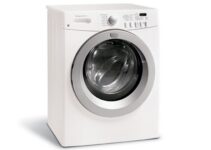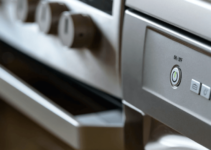A garbage disposal is an indispensable appliance in most kitchens, making it quick and easy to get rid of food scraps. However, like any frequently used appliance, garbage disposals can get dirty over time.
We’ll show you the best way to clean your garbage disposal to ensure it stays fresh and efficient.
Summary
Getting into the habit of regularly deep cleaning your garbage disposal removes gunk buildup, keeps blades sharp, and prevents jams or failures down the road. This straightforward cleaning guide uses common household ingredients. Follow these key steps:
- Unplug and clear debris from disposal
- Remove and scrub splash guard
- Deodorize with baking soda and vinegar mixture
- Scour insides with ice and salt
- Freshen up with lemon or orange peels
When Should I Clean My Garbage Disposal?
Knowing how often to deep clean your garbage disposal is important to keep it working properly long-term. Here are some general guidelines on timing:
- Clean every 2 to 3 months – Regular cleaning every few months prevents buildup of smelly gunk and keeps blades sharp. Set a reminder on your calendar.
- Clean after handling bones, grease, or lots of potato peels – Fibrous veggies and meat scraps quickly lead to jams. Clean soon after putting large amounts down the disposal.
- Clean when you notice bad odors – Strange or unpleasant garbage disposal smells mean debris and residue has built up inside. Schedule a cleaning ASAP.
- Clean after using chemical drain cleaners – Caustic drain solutions can be harsh on disposal metal and parts. Flush with hot water and clean afterwards.
- Clean before leaving home vacant – Whether for vacation or a work assignment, run ice and citrus through the unit before you go to prevent stagnant water smells.
- Clean when installing a new garbage disposal – Scrub away oil and particulates inside the unit from warehouse shelf storage and transport before using for the first time.
Knowing when to clean ensures your garbage disposal always runs fresh and clog-free. Set reminders on your calendar every 10-12 weeks. More frequent cleaning may be needed for busy kitchens prone to grease or big food loads. Listen for strange sounds and smells too.
How to Deep Clean Your Garbage Disposal – A Step-by-Step Guide
Step 1: Unplug the Garbage Disposal
Before cleaning, always unplug the garbage disposal to avoid accidental injury or electric shocks. Locate the plug underneath your sink and disconnect it. You can also turn off the circuit breaker that controls the disposal.
Try turning on the switch after disconnecting to double check the power is off. Never stick your hand in a running disposal!
Step 2: Remove the Splash Guard
The splash guard is the round piece underneath your sink with small drain holes. Lift it out and scrub away any gunk or grease using an old toothbrush and dish soap. Pay extra attention to the grooves and underside.
Rinse the splash guard thoroughly before replacing it. Removing it also gives you access inside the disposal to check for and remove stuck on debris.
<Youtube video 1 on cleaning garbage disposal splash guard.

Step 3: Check and Remove Debris
With the splash guard removed, use a flashlight to peer inside the disposal, looking for any scraps or bones stuck on the blades. Use long handled tongs or needlenose pliers to carefully remove them. Never use fingers, even with the power disconnected.
Step 4: Deodorize with Baking Soda and Vinegar
For a deep clean, use a chemical reaction to power through grease and grime. Pour 1/2 cup baking soda down the drain. Let sit for 30 minutes before slowly pouring in 1 cup white vinegar.
The mix will foam and bubble, loosening debris from inside your disposal. After 3-5 minutes, run hot water to rinse. The baking soda also helps deodorize!
Step 5: Freshen Up with Lemon and Ice
For stubborn buildup or dull blades, use ice and citrus fruits. Stuff used lemon or orange rinds down the drain. Add a few cups of ice cubes. Turn on the cold tap water and power on the disposal.
As the machine grinds away, the ice will sharpen and scour the blades while the citrus lifts odors. Run for 1 minute before turning off.
Image source: https://www.ars.com/
Regular cleaning keeps your garbage disposal running smoothly for years to come!
How to Avoid Bad Garbage Disposal Smells
A foul or rotten egg-like odor coming from the disposal is a common problem. Smelly sinks are unpleasant and the odor can spread through the whole kitchen. Use these tips to avoid bad disposal smells:
- Run Water During Use: Always run cool water into the sink drain while operating the garbage disposal and for 30 seconds afterwards.

- Grind Citrus Rinds: Once a week, grind up leftover citrus peels like orange or lemon rinds.
- Use Enzyme Cleaners: Monthly use an enzyme-based sink drain cleaner product.
- Replace Sink Flange: The sink flange is located inside the drain rim where water goes down. Replace an old, cracked flange, which can collect gunk. A tight seal prevents sneak odors.
- Inspect All Drains: Smelly water could be back flowing from a clogged sink or other drain. Maintain all drains and overflow holes around the kitchen sink area.
With a little diligent cleaning care, you can avoid having a garbage disposal that smells up your kitchen. Invest a few minutes a week on disposal best practices to prevent problems. Contact a plumber if odors persist despite your best efforts.
Garbage Disposal Maintenance Tips: Preventing Problems
While regular deep cleaning keeps your disposal running smoothly, you should also be proactive in preventing problems between cleanings.Implement these tips to avoid gunk buildup, odors, and costly repairs:
Grind Ice Weekly
Drop a tray of ice cubes down the disposal once a week. As the ice grinds, it will scour the inside walls and sharpen the blades. Grinding ice helps prevent grease from sticking and keeps blades sharp, which can prevent jams.
Run Water Before and After Using
Always run cold water before turning on the disposal. Let the water continue flowing for 30 seconds after turning off the disposal as well. The water flow helps flush away residual particles so they don’t stick and build up inside.
Avoid Certain Items
Never pour cooking fats, oils, or grease down the drain and into the disposal. Also don’t put extremely fibrous waste like corn husks or veggie peels down the disposal. Avoid rice or pasta as they can swell up and expand when wet, potentially clogging the drain.
Use a Sink Strainer
Place a sink strainer basket in the kitchen drain to catch bits of food waste and debris. Regularly empty the strainer into the trash can. This helps catch chunks before they have a chance to go down the disposal and clog it.

Check/Replace Splash Guard
Remove and wash out the rubber splash guard 1-2 times per year. Make sure the inspect the guard for any cracks or damage every time you clean it. Replace the splash guard immediately once it becomes worn or torn. Keeping it in good shape helps block foreign objects falling inside the disposal.
Clean All Drains
Use an enzymatic drain cleaning product monthly in the main kitchen sink drain as well as the dishwasher drain line. Pay attention to any debris buildup. Also snake the bathroom shower drain yearly to keep the whole plumbing system clear.
Avoid Harsh Chemicals
Never use caustic chemical drain cleaners directly inside the garbage disposal. Acids and corrosive can damage metal components. Stick to natural baking soda and vinegar treatments when cleaning the disposal instead
When to Call a Professional
While regular deep cleaning and maintenance is easy to do yourself at home, some situations do require calling in a professional:
- Grease buildup: If thick grease persists despite your best cleaning efforts
- Lingering odors: Smells remain after multiple deodorizing treatments
- Removing stuck objects: Dangerous to reach hands inside to clear items
- Replacing rusted parts: Corroded blades or grinding rings need replacement
Even if you stay on top of disposal cleaning, occasionally a professional may be needed for tough grease removal, eliminating difficult odors, safely removing jammed items, or replacing corroded parts. Their experience, equipment and stronger chemicals provide solutions. Don’t hesitate to call them for garbage disposal problems your DIY efforts can’t fix.
Dispose of Food Waste Without Using the Garbage Disposal
While convenient, overuse of the garbage disposal can lead to more wear and tear. Consider these eco-friendly food waste disposal alternatives:
- Compost Vegetable Peels – Egg shells, coffee grounds and produce scraps can create nutrient-rich garden compost instead of overloading your pipes.
- Freeze Leftovers for Broths – Vegetable ends and meat bones make flavorful bases for future soups and stews.
- Donate Edible Foods – Many charities accept leftover packaged and perishable goods to provide meals.
Make Your Own Natural Drain Cleaner
Instead of using harsh chemical drain cleaners, make this natural DIY treatment:
- Pour 1/2 cup baking soda down sink drain
- Add 1/2 cup vinegar and let bubble for 5 minutes
- Boil water and pour down drain to rinse
- Repeat weekly for maintenance
FAQs
How do I clean a smelly garbage disposal?
Grind up citrus rinds to naturally deodorize the disposal. You can also mix baking soda and vinegar, which will dissolve built-up gunk and neutralize odors. For regular maintenance, use drain cleaner enzyme packets monthly.
What is the best thing to use to clean a garbage disposal?
The best way to clean a disposal is using baking soda, vinegar, citrus fruits, and ice cubes right inside the unit itself. Their natural cleaning and abrasive properties dissolve mess without needing harsh chemical cleaners that can erode and damage components.
How do I clean my deeply smelly garbage disposal?
For lingering bad odors even after cleaning, the source could be residue stuck deeper where you can’t scrub manually. Try these aggressive odor-eliminating tips: Pour in drain cleaner enzyme packets and let them work for 8 hours. Run lots of ice cubes through the disposal to scour the inside walls. Sprinkle extra baking soda into the unit before running citrus rinds. If the sink flange collar is very dirty, install a brand new one.





